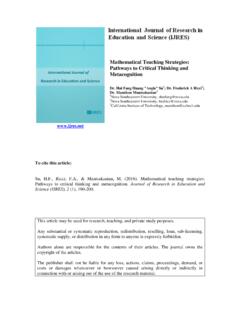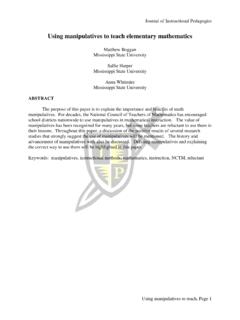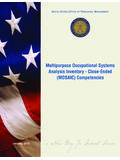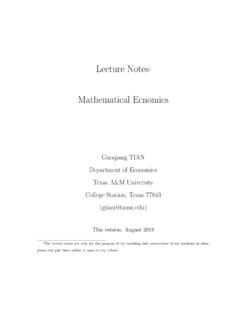Transcription of California Teaching Performance Expectations
1 California Teaching Performance Expectations Commission on Teacher Credentialing Revisions Adopted, March 2013. The California Teaching Performance Expectations Revisions Adopted, March 2013. A. Making Subject Matter Comprehensible to Students TPE 1: Specific Pedagogical skills for Subject Matter Instruction TPE 1A: Subject-Specific Pedagogical Skills for Multiple Subject Teaching Assignments. Teaching English-Language Arts in a Multiple Subject Assignment Teaching Mathematics in a Multiple Subject Assignment Teaching Science in a Multiple Subject Assignment Teaching History-Social Science in a Multiple Subject Assignment TPE 1B: Subject-Specific Pedagogical Skills for Single Subject Teaching Assignments Note: TPE1B addresses each of the thirteen statutory single subject content areas B.
2 Assessing Student Learning TPE 2: Monitoring Student Learning During Instruction TPE 3: Interpretation and use of Assessments C. Engaging and Supporting Students in Learning TPE 4: Making Content Accessible TPE 5: Student Engagement TPE 6: Developmentally Appropriate Teaching Practices TPE 6A: Developmentally Appropriate Practices in Grades K-3. TPE 6B: Developmentally Appropriate Practices in Grades 4 8. TPE 6C: Developmentally Appropriate Practices in Grades 9 12. TPE 7: Teaching English Learners D. Planning instruction and Designing Learning Experiences for Students TPE 8: Learning About Students TPE 9: Instructional Planning E. Creating and Maintaining Effective Environments for Student Learning TPE 10: Instructional Time TPE 11: Social Environment F.
3 Developing as a Professional Educator TPE 12: Professional, Legal, and Ethical Obligations TPE 13: Professional Growth California Teaching Performance Expectations 1 Adopted 2013. A. MAKING SUBJECT MATTER COMPREHENSIBLE TO STUDENTS. TPE 1: Specific Pedagogical Skills for Subject Matter Instruction Background Information for TPE 1: TPE 1 is divided into two categories intended to take into account the different Teaching assignments of Multiple Subject and Single Subject credential holders. Multiple subject credential holders work in self-contained classrooms and are responsible for instruction in several subject areas. Single subject credential holders work in departmentalized settings and have more specialized assignments.
4 TPE 1A: Subject-Specific Pedagogical Skills for Multiple Subject Teaching Assignments Teaching English-Language Arts in a Multiple Subject Assignment Multiple Subject candidates demonstrate the ability to teach the state- adopted academic content standards to students. They understand how to deliver a comprehensive program of rigorous instruction in Reading, Writing, Speaking and Listening, and Language within standards that establish a progression of increasing complexity. They strategically plan and schedule instruction that ensures that students meet or exceed the standards. Candidates create a print-rich environment where students learn to read and write, comprehend and compose, appreciate and analyze, and perform and enjoy the language arts.
5 They understand how to use instructional materials that include a wide range of increasingly complex literary and informational texts for the appropriate grade level. They select appropriate Teaching strategies to develop students' abilities to read and comprehend narrative and informational texts and to cite specific evidence when offering an oral or written interpretation of a text. They select appropriate Teaching strategies to develop students' abilities to write increasingly more sophisticated opinion/persuasive, expository and narrative texts and for students to adapt their communication in relation to audience, task, purpose, and discipline.
6 Candidates provide opportunities for students to read purposefully and listen attentively to build discipline-specific knowledge in the content areas. Candidates provide opportunities for students to develop oral communication and interpersonal skills. Candidates encourage students' use of language to extend across reading, writing, speaking, and listening. They make language (vocabulary, conventions, and knowledge of language) comprehensible to students. They provide students the opportunity to use and evaluate strengths and limitations of media and technology as integral tools in the classroom. Candidates know how to determine the skill level of students through the use of meaningful indicators of reading and language arts proficiency prior to instruction, how to determine whether students are making adequate progress on skills and concepts, and how to determine the effectiveness of instruction and students' proficiency after instruction.
7 Teaching Mathematics in a Multiple Subject Assignment Multiple Subject candidates demonstrate the ability to understand and teach the progression of the state-adopted academic content standards for students in mathematics. They facilitate students' development of the knowledge and skills required to (a) appropriately use processes of problem solving, reasoning and proof, communication, representation, and connections in real California Teaching Performance Expectations 2 Adopted 2013. world situations, and (b) appropriate apply the strands of mathematical proficiency, including adaptive reasoning , strategic competence, conceptual understanding, procedural fluency, and productive disposition.
8 Candidates facilitate student understanding of mathematical concepts and support students in making and testing conjectures and recognizing relationships within and among concepts. They provide students the opportunity to use and evaluate strengths and limitations of media and technology as integral tools in the classroom. Candidates provide a secure environment for taking intellectual risks and they model and encourage students to use multiple approaches to mathematical problems. They require student collaboration and written and oral communication that demonstrates students' ability to construct logical arguments based on substantive claims, sound reasoning , and relevant evidence.
9 They foster positive attitudes toward mathematics, encourage student curiosity, academic discourse, and persistence in solving mathematical problems. Teaching Science in a Multiple Subject Assignment Multiple Subject candidates demonstrate the ability to teach the state-adopted academic content standards for students in science. They balance the focus of instruction between science information, concepts, and investigations. Their explanations, demonstrations, and class activities serve to illustrate science concepts and principles, scientific investigation, and experimentation. Candidates emphasize the importance of accuracy, precision, and estimation.
10 Candidates teach students to independently read and comprehend instructional materials that include increasingly complex subject-relevant texts and graphic/media representations presented in diverse formats. Candidates also teach students to write opinion/persuasive and expository text in the content area. They provide students the opportunity to use and evaluate strengths and limitations of media and technology as integral tools in the classroom. Teaching History-Social Science in a Multiple Subject Assignment Multiple Subject candidates demonstrate the ability to teach the state-adopted academic content standards for students in history-social science.

















